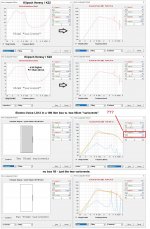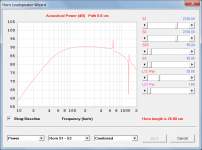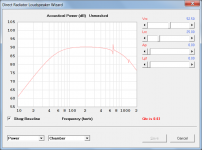Here's a try using a Klipsch Heresy I with K22 spec woofer.
I may have not damped the port enough.
The Z peak, normally in the 65Hz region is flattened. Some peaking in the response curve shows (as does significant port output)
I may have not damped the port enough.
The Z peak, normally in the 65Hz region is flattened. Some peaking in the response curve shows (as does significant port output)
Attachments
Hi GM, do you mean a different approach to the simulations posted above ?
In those I adjusted the impedance peak via fill density in a section about the size or so of the SS Variovent.
The outcome with my input caused some peaking vs the idea of being able to flatten Z and improve response.
(with the lower Z, more current would be drawn in the area centered by the peak ...)
I see with the newest version of hornresp, response and input Z can be manipulated via low values of Ql - but have no
idea how that might be done.
In those I adjusted the impedance peak via fill density in a section about the size or so of the SS Variovent.
The outcome with my input caused some peaking vs the idea of being able to flatten Z and improve response.
(with the lower Z, more current would be drawn in the area centered by the peak ...)
I see with the newest version of hornresp, response and input Z can be manipulated via low values of Ql - but have no
idea how that might be done.
Last edited:
Here's a try using a Klipsch Heresy I with K22 spec woofer.
I may have not damped the port enough.
Hi freddi,
The only changes I would perhaps make would be to increase the port cross-sectional area from 45 cm2 to 95 cm2 (giving a vent diameter of 110 mm) and increase the Fr1 value. The attached table may help in determining what would be an appropriate airflow resistivity value to use.
Kind regards,
David
Attachments
Hi GM, do you mean a different approach to the simulations posted above ?
Greets!
No, just the density value has to be quite high as DB kindly shows in his chart. The pioneer's cotton, wool, used is incredibly dense compared to what we use nowadays.
Frankly, some of those old damped vent cabs I've been exposed to seemed to rely more on box and/or driver leaks, the vent was so dense, especially those coated with various types of smoke residue typical of the times.
Freddi,
The biggest issue with modeling an aperiodic vent (the varivent is a crude example), one needs to know the characteristics of the damping materials used at the density it needs to be used at are still largely ust guesses. No one (that i know of) has actually done the needed measures.
dave
The biggest issue with modeling an aperiodic vent (the varivent is a crude example), one needs to know the characteristics of the damping materials used at the density it needs to be used at are still largely ust guesses. No one (that i know of) has actually done the needed measures.
dave
Are Fr1s at "19000" even feasible / doable ?
Hi Freddy,
A value of 19000 is certainly doable if something like Rockwool insulation is used, but it would sort of defeat the purpose of the exercise as the contributing output from the vent would then be very much reduced due to the high resistance, and the performance of the overall system would tend towards that of a simple closed box.
Attachment 1 shows the power response with a single '19000' Variovent, and Attachment 2 shows the response of a closed box system having the same volume and driver.
Kind regards,
David
Attachments
- Home
- Loudspeakers
- Subwoofers
- How might one set hornresp to examine the "variovent" case?





